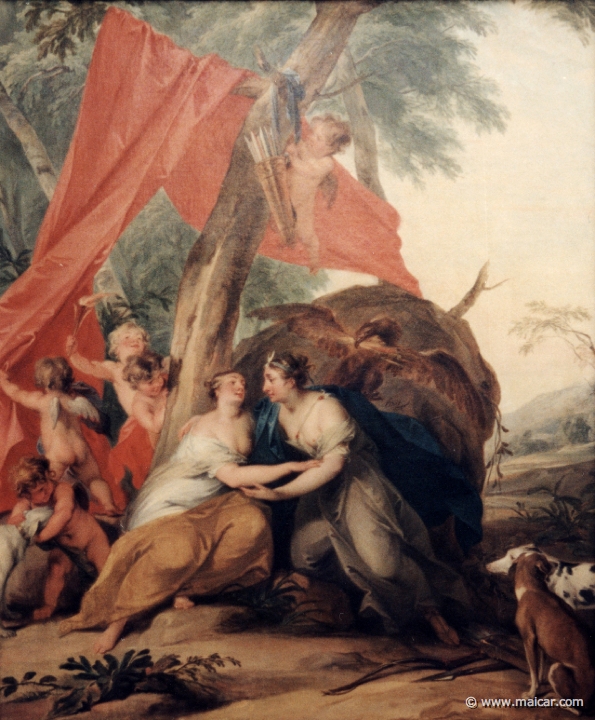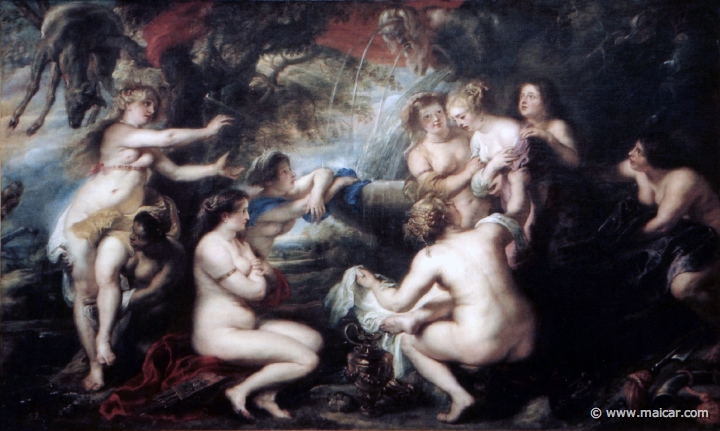 |
|
|

|
Callisto and Zeus as Artemis. The presence of Zeus' eagle shows that things are not as they look. 3822: Zeus (as Artemis) and Callisto. Jacob de Wit 1695-1754: Jupiter disguised as Diana, seducing the nymph Callisto. Rijksmuseum, Amsterdam.
|
|
Callisto consorted with Zeus and gave birth to Arcas 1, the eponym of the Arcadians. She was punished for being Zeus' lover, and was turned into a bear, but gained immortality by being among the stars.
In the train of Artemis
This daughter of impious Lycaon 2 lived in Arcadia, and used to hunt in the company of Artemis to whom she had sworn to remain a maid; for a main feature of this goddess is never to yield to men.
Zeus disguised
Zeus, however, assuming the shape of Artemis, or as some say the shape of Apollo, seduced Callisto and, not wishing to be detected by jealous Hera, transformed the girl into a bear. But as jealousy has innumerable resources, Hera, having learned what had happened, asked Artemis to shoot the bear, which the latter did. There are those, however, who affirm that Artemis shot the beast after Hera had turned the girl into a bear because Callisto failed to fulfil her promise concerning her maidenhood.
"For I will take away your beauty, wherewith you do delight yourself and him who is my husband." (Hera to Callisto. Ovid, Metamorphoses 2.472).
The virgin goddess punishes Callisto
Others have said that Artemis was not satisfied with merely expelling Callisto from her train:
"Begone! and pollute not our sacred pool." (Artemis to Callisto. Ovid, Metamorphoses 2.472).
but also changed her into a bear, after noticing, when Callisto was refreshing her body in a stream, that the girl's womb had grown heavier. For she asked the girl as to the reason for her swollen form, and when Callisto, whom Zeus seduced assuming Artemis' shape, answered that it was the goddess' fault, she, angry at the girl's reply, changed her into a bear, and in this animal form she later bore her son Arcas 1.
Fate of mother and child
In any case, because of this intrigue Callisto died, but Zeus, in order to save her and her child from an angry mob, transformed her into the constellation Great Bear (Ursa Major), thus allowing her to gain immortality, and gave their child Arcas 1 to Hermes' mother, the Pleiad Maia, for upbringing. Yet those who like to compare details and how they agree with each other say, for example, that the constellation is not Callisto herself, but that it was put in the sky to honour her, for, they argue, the Arcadians themselves were able to point at her grave. It is also told that the constellation of the Great Bear never sets because Tethys forbade her to dip herself in the ocean, and that this is so because Oceanus's wife Tethys hated Callisto's intrusion; for Tethys was Hera's nurse, and Callisto a concubine in Hera's bed.
|

|
Artemis (left) discovers Callisto's pregnancy.
9821: Peter Paul Rubens 1577-1640: Diana y Calisto. Museo Nacional del Prado.
|
|
Her child holds her company in the sky
Arcas 1, the son of Zeus and Callisto who some said was the child that impious Lycaon 2 served Zeus at a banquet, became king, and the district of Arcadia, formerly called Pelasgia, is called after him. After his death, he was turned into the constellation Bear-Watcher (Bootes) that guards the Great Bear, but others have said that Bootes is someone else (Icarius 2, father of Erigone 2, the man who was killed by drunkards).
|
| Family |
|
|
|
|
|
|
|
|

|
|
|
|
|
|
Nycteus 1 is son of Poseidon and Celaeno 2, one of the PLEIADES.
- Nonacris is also known for a city in Arcadia that was named after her.
- Ceteus 1 is son of Lycaon 2. He had another daughter called Megisto.
|
|

Zeus
|
King Arcas 1 of Arcadia is credited with the introduction of the cultivation of crops, which he learned from Triptolemus, and with having taught men to make bread, weave clothes, etc.
Different names have been given to the wife of Arcas 1:
- Leanira, daughter of Amyclas 1, son of Lacedaemon, son of Zeus and the Pleiad Taygete.
- Laodamia 3, daughter of Amyclas 1.
- Meganira, daughter of Croco.
- Chrysopelia, a nymph.
- Erato 1, a dryad nymph.
His children, Elatus 2 and Aphidas 1, divided Arcadia between them, but Elatus 2 had all the power.
Later, Elatus 2 migrated to Phocis, the region bordering the Gulf of Corinth west of Boeotia, helped the Phocians against the Phlegyans and founded the city of Elateia. Elatus 2's son Stymphalus 1 reigned in Arcadia until he was treacherously murdered by Pelops 1.
Aphidas 1 is father of Aleus, father of Auge 2, mother of Telephus by Heracles 1.
Another son Azan, after whom the district of Azania in Arcadia was called, is father of Coronis 2, mother of Asclepius by Apollo.
Autolaus is said to be Arcas 1's illegitimate son. He found the exposed child Asclepius and brought him up. But some call Aresthanas the herdsman who found the child Asclepius exposed.
Arcas 1's daughter Hyperippe 2 married, some say, Endymion, the man who chose to sleep forever remaining ageless and deathless, and had children by him, among which Epeius 1 (see Elis).
Other children of Arcas 1 are Erymanthus 2, Diomenia and Triphylus.
Arcas 1 was buried in Mantinea, after his bones were brought from Maenalus, following the oracle of Delphi, which said:
Maenalus is storm-swept, where lies Arcas, from whom all Arcadians are named, in a place where meet three, four, even five roads; there I bid you go, and with kind heart take up Arcas and bring him back to your lovely city. There make Arcas a precinct and sacrifices. (The Oracle of Delphi. Pausanias 8.9.4).
|
|
|
|
|
|